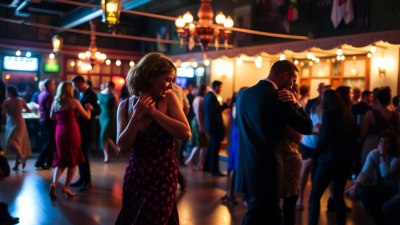Buenos Aires' Tango Milongas: Dancing Till Dawn with Locals
Explore the vibrant tango milongas of Buenos Aires for an authentic dance experience with locals.

Buenos Aires, the capital of Argentina, is the heart and soul of tango. This passionate dance has evolved over the years, becoming not just an art form but a way of life for many locals. Tango milongas are social dance events that showcase the intricate footwork and sultry movements of the dance while fostering a sense of community among dancers. With its dimly lit streets and vibrant night life, Buenos Aires offers an unparalleled experience for anyone wishing to immerse themselves in the world of tango.
The essence of tango milongas goes beyond just dancing; it's about connection, community, and tradition. As you step into a milonga, you are greeted by the sounds of passionate music and the rhythmic footsteps of dancers swaying across the floor. Many people often wonder how to navigate this vibrant world. Here’s what to expect, how to dance, and why you should join the locals till dawn.
The History of Tango
Tango has its roots in the working-class neighborhoods of Buenos Aires in the late 19th century. Influenced by African rhythms and European musical styles, tango emerged as a form of expression among immigrants and the working class. By the early 20th century, tango had gained popularity and evolved into the romantic, dramatic dance we know today. The music, characterized by its emotional depth, tells stories of love, heartache, and passion, making it a timeless art form.
Today, tango is recognized worldwide and has become a symbol of Argentine culture. It has gained acclaim for its unique improvisational aspects, allowing dancers to express themselves in a myriad of ways. Many of the original milongas, or venues for tango dancing, still exist in the city, which allows the tradition to thrive. These venues attract both locals and tourists seeking to experience authentic tango dance.
In Buenos Aires, milongas come in various styles, with some catering to different skill levels and atmospheres. For instance, traditional milongas focus on the classic tango approach, emphasizing respect and proper etiquette on the dance floor. In contrast, alternative milongas might incorporate eclectic music and styles, inviting dancers to express themselves freely.
Each milonga can have its distinct energy; some might be formal with structured practices, while others are more relaxed and casual, welcoming newcomers to join in the rhythm. Understanding the subtle differences between these milongas can significantly enhance your experience. Depending on what you're looking for, you can find a milonga that suits your vibe.
As with any social gathering, knowing the etiquette of tango milongas is crucial to enjoying the experience fully. When you enter a milonga, you'll notice that the dance floor is organized with certain codes of conduct. Here are some essential tips to keep in mind:
1. **The Cabeceo**: This is the traditional way of inviting someone to dance. Instead of directly approaching someone, make eye contact and nod your head to indicate your interest. This method maintains a degree of formality and respect in the dancing environment.
2. **Respect the Dance Floor**: The dance floor operates much like a road; there is a flow to the movement. Couples will generally move clockwise, and it’s essential to be aware of your surroundings. Avoid cutting in front of other dancers and always look ahead.
3. **Dress Appropriately**: While there's no hard and fast rule, it’s customary to dress well for a milonga. Most dancers opt for elegant outfits to match the beautiful ambiance of the evening.
4. **Thank Your Partner**: After a dance, it’s polite to thank your partner and acknowledge the moment shared.
5. **Be Open**: If you’re new to tango, don’t hesitate to ask for a dance. Most locals are very welcoming and will appreciate your willingness to learn.
With countless milongas scattered across the city, it can be challenging to choose which ones to visit. Here are some of the most popular milongas known for their vibrant atmospheres and rich tango traditions:
1. **La Viruta**: Located in the Palermo neighborhood, La Viruta is known for its relaxed vibe and dance classes before the milonga begins. It’s a popular spot for both locals and tourists, making it a great place to meet fellow tango enthusiasts.
2. **El Club de Tango**: A historical venue situated in the San Telmo district, El Club de Tango offers a traditional milonga experience complete with elegant decor and live music. It often hosts guest musicians, adding a unique flair to the event.
3. **Salon Canning**: Known for its beautiful wooden dance floor and large crowd, Salon Canning is a favorite among seasoned tango dancers. The atmosphere is energetic, and the venue regularly features live orchestras, bringing the music and dance together harmoniously.
4. **Milonga 10**: This milonga is perfectly designed for those who wish to dance late into the night. With its welcoming atmosphere and emphasis on community, it's a wonderful place for both novices and experts alike.
If you're new to tango, taking some lessons before immersing yourself in a milonga atmosphere can be very helpful. Tango lessons are widely available throughout the city, and many teachers specialize in different aspects of the dance, from basic footwork to more complex figures. It's a fantastic way to refresh your skills and gain confidence before hitting the dance floor.
Additionally, attending a pre-milonga class at venues like La Viruta can be an excellent way to learn while enjoying the social setting. The hour or two of instruction often allows you to meet fellow learners and immerse yourself in the tango culture before the night truly begins.
One of the best aspects of participating in tango milongas in Buenos Aires is the sense of community. Many dancers consider tango to be a family affair, making it easy for newcomers to feel welcomed. Engaging with locals during and after the milonga can lead to new friendships and a deeper understanding of the dance.
During breaks between dances, you can join the conversation, inquire about dance tips, or even participate in impromptu lessons. The tango community is known for being supportive, and this camaraderie can make your experience much more enjoyable.
While milongas are a fantastic way to experience tango culture, there are various other activities to partake in during your stay in Buenos Aires. Consider attending live tango shows in historic theaters, such as Café Tortoni or the famous Esquina Carlos Gardel, which showcases the beauty of tango through theatrical performances.
Additionally, exploring historical neighborhoods such as San Telmo or La Boca can provide a glimpse into the vibrant culture that inspired tango music and dance. Street performers often showcase tango in public squares, adding a lively flair to your exploration of the city.
To truly immerse yourself in the tango culture of Buenos Aires, try to combine multiple elements of this rich tradition. Take dance classes, visit milongas, and attend live shows to understand the different expressions of tango deeply. Spend time talking with the dancers, sharing stories, and learning about their connection to this art form.
Finally, don't forget to relish the moments of spontaneity that tango can offer; the joy of connection, the shared laughter during a misstep, or the electric thrill of a well-executed dance. These experiences will become cherished memories that accompany you home.
In Buenos Aires, the tango is not just a dance; it represents a connection to the past and a celebration of life. Engaging with locals at milongas allows you to experience this art form in its most authentic state. So, prepare your dancing shoes, embrace the rhythm, and let the magic of tango sweep you off your feet till dawn.











